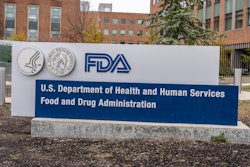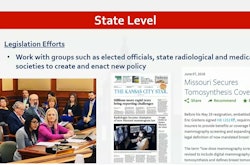September 10 marks a big day in breast health as the federal mandate on breast density notification takes effect.
The mandate, part of the U.S. Food and Drug Administration’s (FDA) Mammography Quality Standards Act (MQSA), requires health providers to notify women of their breast density. Breast imaging advocates have applauded the mandate since the FDA announced its planned implementation in 2023.
“We’re happy there’s some clarification on breast notification laws,” said Stamatia Destounis, MD, from Elizabeth Wende Breast Care in Rochester, NY. “This is going to bring us closer together and patients will understand the reporting. The referring physicians will get similar reports. The doctors at every mammography facility will have to give the same lay letter to the patients.”
Radiology researchers in more recent years have studied different methods of best practice for imaging women with dense breasts. Conventional mammography struggles to detect cancers in dense breasts, as the higher proportion of fibroglandular tissue creates a “masking” effect. Imaging societies such as the American College of Radiology (ACR) recommend supplemental breast MRI for women with dense breasts.
As of September 2024, 39 states and the District of Columbia have their own breast density notification laws. However, facilities will now have to reconcile their respective state’s dense breast notification laws with the federal mandate. Advocates say this will help educate women about their own breast density.
“Everyone at least now has the same level of basic information,” said JoAnn Pushkin, founder of Densebreast-info.org. “This is actionable information. They can do their own research on the topic and engage their providers. They become educated consumers for their own health.”
AuntMinnie.com · Podcast on breast density notification law
Pushkin helped found Densebreast-info.org in 2015 after her own cancer scare in 2005. While her mammogram yielded negative results, a subsequent ultrasound found breast cancer. It was the first time she had ever heard of the concept of dense breasts, as is the case for many women in states with no such notification laws.
She wrote to the FDA in 2010 about including a requirement to notify women of their breast density and testified before the agency in 2011, which agreed that women should have the information. From there, Pushkin and colleagues began offering educational tools via Densebreast-info.org and began celebrating World Dense Breast Day in 2022, which occurs each year on the last Wednesday of September.
“[The mandate] will save lives. There’s just no doubt about it,” she said. “But my heart aches for the women who have worked on getting laws passed in their individual states who aren’t with us anymore to celebrate. This happened on the back of sick and dying women, frankly.”
While September 10 may be a day to celebrate, breast imaging advocates say there is much work ahead. Two barriers include access to follow-up imaging such as MRI and ultrasound, and insurance coverage for supplemental imaging.
A 2024 study found that women on average must travel three times further for supplemental ultrasound and MRI than to their closest mammography facility. MRI’s high cost can also deter some patients from attending their supplemental screening.
Researchers are exploring how alternative options such as abbreviated MRI and contrast-enhanced mammography (CEM) can help without sacrificing imaging quality.
Wendie Berg, MD, PhD, from the University of Pittsburgh, has been researching CEM’s potential as a supplemental modality. Studies she has led in recent years have found that CEM is preferred among many women over MRI and that the modality can be a suitable alternative for imaging invasive lobular carcinoma.
“CEM has a lot of potential to really be something we can implement much more broadly,” said Berg, who is also a co-founder of Densebreast-info.org. “It is so much easier to implement because it can generally be a software upgrade to a mammography machine. And we know mammogram machines are more widely available.”
She added that facilities exploring CEM as an option will need staff training on contrast injections and managing allergic reactions some patients may experience. Still, the modality needs federal backing before being more widely available for women with dense breasts.
Berg had her own breast cancer experience in 2014. A mammogram did not identify any suspicious findings, but an MRI exam nearly six months later showed cancer.
“The experience resulted in a subtle shift in my conversations with patients,” she wrote in a 2015 editorial for AuntMinnie.com. “When we're discussing ultrasound-guided core biopsy, I can share -- from a patient's perspective -- that it is truly easier than getting a dental filling. More than a few of my patients have commented that observing me functioning well makes it easier for them to envision themselves on the ‘other side of the mountain’ and resuming their own normal life after treatment.”
As for insurance coverage, 32 states and the District of Columbia have their own laws mandating that insurance providers cover supplemental imaging. However, state laws can vary, adding further to the confusion.
“Self-funded plans can be exempt, federal plans like Medicare can be exempt, and out-of-state plans can be exempt,” Pushkin said. “Even with a state insurance law, we are leaving a lot of cancers on the table and a lot of women in the dust.”
The bipartisan Find It Early Act has been making its rounds in Congress. The act would require private and government insurers to cover out-of-pocket costs often faced by high-risk women who need supplemental imaging to diagnose their cancer. Imaging societies have expressed support for the act, which was introduced in December 2022. However, the act has not been voted on as of September 2024.
“There’s a real push to have patient coverage for everything we’re explaining to them that they may be at risk for, based on their breast density or other risks,” said Destounis, who is also chair of the American College of Radiology’s (ACR) Commission on Breast Imaging.
Still, the federal mandate is a step in the right direction for the women of today and tomorrow, advocates say.
“Our patients are getting more well-versed,” Destounis added. “I think any movement toward allowing patients to be able to get screened for breast cancer and have supplemental screening available is important and will be life-saving not just for the patient but for the entire family. We’re on a path to identify breast cancer early and try to eradicate it.”



















